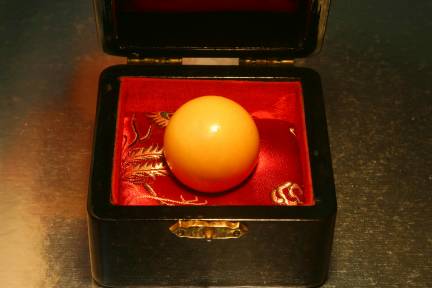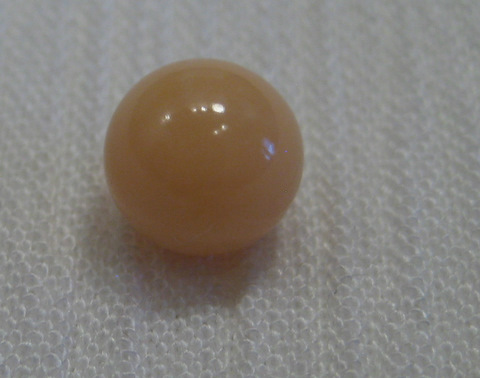|
Yellow PearlsSpeaking of yellow pearls, I was fortunate to see a super large cultured south sea golden pearl at Mikimoto Pearl Island.
I don't know its actual measurement, but it would probably be too large for any piece of jewelry and close to the size of a ping pong ball and similar in size to the melo pearl in the photo below. It was perfectly round with a wonderful luster and valued at around $350,000. The melo pearl in the photo is worth several million dollars.  Largest Roundest Most Perfect Melo Pearl in the World The following information is from Kunz and Stevenson's, "The Book of the Pearl," published in 1908....special thanks. This page is about natural yellow pearls and does not cover the lovely cultured south sea yellow pearls made today. The Persian Gulf pearls are commonly not so white as those from Ceylon, but they are found of larger size, and it is believed in Asia that they retain their luster for a greater length of time. Many of the Persian Gulf pearls, especially those from sudaifee and Zinni shells, have a distinctly yellow color. Tavernier made a curious (and erroneous) explanation of this. He said: As for the pearls tending to yellow, the color is due to the fact that the fishermen sell the oysters in heaps, and the merchants awaiting sometimes up to 14 or 15 days till the shells open of themselves, in order to extract the pearls, some of these oysters lose their water during this time, decay, and become putrid, and the pearls become yellow by contact. This is so true that in all oysters which have retained their water, the pearls are always white. They are allowed to open of themselves, because if they are opened by force, as we open our oysters in the shell, the pearls may be damaged and broken. The oysters of the Manar Strait open of themselves, 5 or 6 days sooner than those of the Gulf of Persia, because the heat is much greater at Manar, which is at the tenth degree of North latitude, while the island of Bahrain is at about the twenty-seventh. And consequently among the pearls which come form Manar there are few yellow ones found. 1 Tavernier was more familiar with the pearls themselves than with the methods of the fishery. The yellow color is not due to contact with the putrefactive flesh, and is independent of the manner of opening. In fact, if putrefaction caused the yellow color, this shade would be far more prevalent in the Manaar or Ceylon pearls than in those from Bahrain, for practically all of the Ceylon oysters are permitted to putrefy, whereas only a portion of those in the Persian Gulf are opened in this manner. Furthermore, notwithstanding that it is nearer the equator, the heat at Manaar during the pearling season is not to be compared with that at Bahrein when the season is at its height, for the Persian Gulf during July and August is notorious as one of the hottest places on the globe. While the great bulk of the pearls are either white or yellowish, these fisheries yield a few pink, bluish, gray, and occasionally even black pearls. These unusual colors are not especially prized. Most of the yellow pearls from the gulf find oriental purchasers, with whose dark complexions they harmonize better than the silvery white ones. The pearls from Shark's Bay, in the Pacific, are commonly yellowish or straw colored, and sometimes have a beautiful golden tinge. Although obtained from small shells, they are sometimes of considerable size--twenty grains or more in weight, and fine specimens sell for several hundred dollars each. China and India furnish better markets for them than Europe or America.  Yellow Conch Pearl Some of the lesser known mollusk varieties which produce yellow pearls include the common Conch (Strombus gigas) or the yellow shelled conch (Cassis madagascarensis); Abalone; Pinna or Wing Shells, which are almost translucent and have a peculiar red or yellow color; pearly Nautilus (Nautilus pompilius); and the Melo. Nearly all the Venezuela and Panama pearls have a faint golden-yellow tint, very often extremely lustrous, and are especially desired by the darker skinned people and brunettes. Yellow pearls from other shells than the pearl-oyster are frequently offered for sale in the East, where they are greatly appreciated, although they find little favor in England. Some of these pearls are attributed to the pearly nautilus. This may be the case with those that have a pearly luster, but those that have the appearance of porcelain, and are as bright as polished china, are certainly not from this shell, but evidently from the large Melo or other shells of that character. Some may come from the large conch. A yellow pearl, very perfect in form and color, and weighing more than one hundred grains, was shown at the Paris Exposition of 1889 and was valued at 50,000 francs. Wonderful golden yellow pearls with a saffron tint are unusually lustrous and beautiful. One of the most remarkable pearls of this character is of a brilliant golden-yellow color which belongs to an American lady, and weighs 30 1/2 grains. These pearls are from Shark's Bay, West Australia, and only a limited number of them are found annually. Yellowish pearls are sometimes bleached by means of strong bleaching substances such as chlorine or other powerful reagents, which, although they may whiten the pearl, cause it to become very friable, as the animal substance becomes more brittle. Pearls treated in this way frequently wear off, layer by layer, until fully one half of the pearl is worn out of the setting. When pearls are stained yellowish from the exudations of the skin, grease, or other impurities, they can be cleaned by putting them in moist caustic magnesia and allowing it to dry on them. When this is removed, the pearls will often be found much purer in color than before. 1. Tavernier, "Travels in India," Ball edition, Vol II, pp.114,115 |






